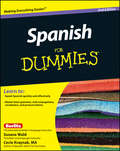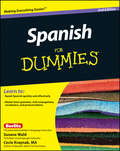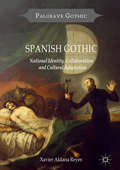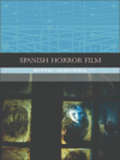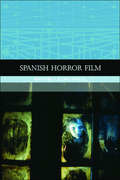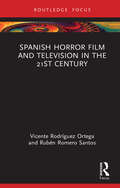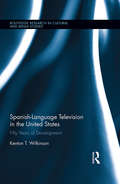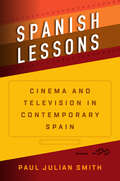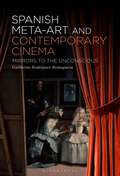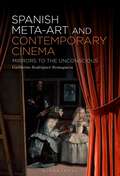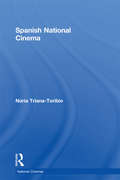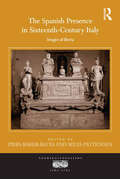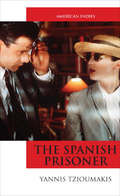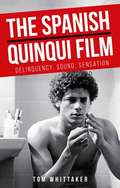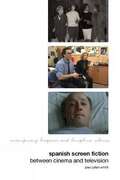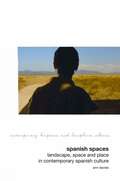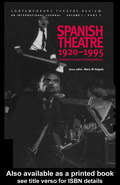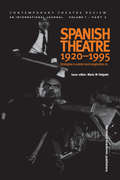- Table View
- List View
Spanish For Dummies
by Susana Wald Cecie KraynakLearn Latin American Spanish quickly and painlessly The job market for those who are bilingual is expanding rapidly. Businesses and government agencies are hiring translators; retailers and advertisers are concentrating more energy in targeting the Spanish-speaking ; and hospitals and agencies are seeking to overcome language barriers. Whether you’re a student studying Spanish, a traveler gearing up for a trip to a Spanish-speaking country and need to learn the basics, or a upwardly mobile looking to get ahead of the pack in your career by learning a second language, Spanish For Dummies, 2nd edition is your hands-on guide to quickly and painlessly learn Latin American Spanish that includes: Expanded coverage of grammar, verb conjugations, and pronunciations A refreshed and expanded mini-dictionary complete with even more essential vocabulary, exercises, and more A revamped and expanded bonus CD-ROM that includes real-life dialogue to aid in your learning Whether you’re looking to learn Spanish for use in the home, class, at the office, or on the go, Spanish For Dummies, 2nd edition has you covered!
Spanish For Dummies
by Susana Wald Cecie KraynakLearn Latin American Spanish quickly and painlessly The job market for those who are bilingual is expanding rapidly. Businesses and government agencies are hiring translators; retailers and advertisers are concentrating more energy in targeting the Spanish-speaking ; and hospitals and agencies are seeking to overcome language barriers. Whether you’re a student studying Spanish, a traveler gearing up for a trip to a Spanish-speaking country and need to learn the basics, or a upwardly mobile looking to get ahead of the pack in your career by learning a second language, Spanish For Dummies, 2nd edition is your hands-on guide to quickly and painlessly learn Latin American Spanish that includes: Expanded coverage of grammar, verb conjugations, and pronunciations A refreshed and expanded mini-dictionary complete with even more essential vocabulary, exercises, and more A revamped and expanded bonus CD-ROM that includes real-life dialogue to aid in your learning Whether you’re looking to learn Spanish for use in the home, class, at the office, or on the go, Spanish For Dummies, 2nd edition has you covered!
Spanish Gothic: National Identity, Collaboration and Cultural Adaptation (Palgrave Gothic)
by Xavier Aldana ReyesThis book presents the first English introduction to the broad history of the Gothic mode in Spain. It focuses on key literary periods, such as Romanticism, the fin-de-siècle, spiritualist writings of the early-twentieth century, and the cinematic and literary booms of the 1970s and 2000s. With illustrative case studies, Aldana Reyes demonstrates how the Gothic mode has been a permanent yet ever-shifting fixture of the literary and cinematic landscape of Spain since the late-eighteenth century. He proposes that writers and filmmakers alike welcomed the Gothic as a liberating and transgressive artistic language.
Spanish Horror Film (Traditions In World Cinema Ser.)
by Antonio Lázaro-RebollSpanish Horror Film is the first in-depth exploration of the genre in Spain from the 'horror boom' of the late 1960s and early 1970s to the most recent production in the current renaissance of Spanish genre cinema, through a study of its production, circulation, regulation and consumption. The examination of this rich cinematic tradition is firmly located in relation to broader historical and cultural shifts in recent Spanish history and as an important part of the European horror film tradition and the global culture of psychotronia.Key Features*The first critical study on Spanish horror film to be published in English.*An overview of key directors, cycles and representative films as well as of more obscure and neglected horror production.*A detailed analysis of the work of directors such as Jesús Franco, Amando de Ossorio, Narciso Ibáñez Serrador, Eloy de la Iglesia, Jaume Balagueró, Nacho Cerdá and Guillermo del Toro's "Spanish" films.*A focus on critical and cult contexts of reception in Spain, Great Britain and USA.
Spanish Horror Film (Traditions in World Cinema)
by Antonio Lázaro-RebollAn original new study of Spanish horror film.
Spanish Horror Film and Television in the 21st Century (Routledge Focus on Media and Cultural Studies)
by Vicente Rodríguez Ortega Rubén Romero SantosThis book provides an up-to-date, in-depth survey of 21st-century Spanish horror film and media, exploring both aesthetics and industrial dynamics. It offers detailed analysis of contemporary films and TV series as well as novel approaches to key works within the history of Spanish cinema. While addressing the specificities of the Spanish landscape, this volume also situates the national cinematic output within the international arena, understanding film production and reception as continuously changing processes in which a variety of economic, social and cultural factors intervene. The book first analyzes the main horror trends emerging in the early 2000s, then approaches genre hybridization and the rise of new filmmakers since the 2010s with a special focus on gender issues and the reconfiguration of the past, before addressing the impact of streaming services within the Spanish film panorama, from a production and distribution standpoint. This book will be of keen interest to scholars and students in the areas of film studies, media studies, TV studies, horror, Spanish cultural studies and production studies.
Spanish Horror Film and Television in the 21st Century (Routledge Focus on Media and Cultural Studies)
by Vicente Rodríguez Ortega Rubén Romero SantosThis book provides an up-to-date, in-depth survey of 21st-century Spanish horror film and media, exploring both aesthetics and industrial dynamics. It offers detailed analysis of contemporary films and TV series as well as novel approaches to key works within the history of Spanish cinema. While addressing the specificities of the Spanish landscape, this volume also situates the national cinematic output within the international arena, understanding film production and reception as continuously changing processes in which a variety of economic, social and cultural factors intervene. The book first analyzes the main horror trends emerging in the early 2000s, then approaches genre hybridization and the rise of new filmmakers since the 2010s with a special focus on gender issues and the reconfiguration of the past, before addressing the impact of streaming services within the Spanish film panorama, from a production and distribution standpoint. This book will be of keen interest to scholars and students in the areas of film studies, media studies, TV studies, horror, Spanish cultural studies and production studies.
Spanish-Language Television in the United States: Fifty Years of Development (Routledge Research in Cultural and Media Studies)
by Kenton T. WilkinsonSince its introduction in the early 1960s, Spanish-language television in the United States has grown in step with the Hispanic population. Industry and demographic projections forecast rising influence through the 21st century. This book traces U.S. Spanish-language television’s development from the 1960s to 2013, illustrating how business, regulation, politics, demographics and technological change have interwoven during a half century of remarkable change for electronic media. Spanish-language media play key social, political and economic roles in U.S. society, connecting many Hispanics to their cultures of origin, each other, and broader U.S. society. Yet despite the population’s increasing impact on U.S. culture, in elections and through an estimated $1.3 trillion in spending power in 2014, this is the first comprehensive academic source dedicated to the medium and its history. The book combines information drawn from the business press and trade journals with industry reports and academic research to provide a balanced perspective on the origins, maturation and accelerated growth of a significant ethnic-oriented medium.
Spanish-Language Television in the United States: Fifty Years of Development (Routledge Research in Cultural and Media Studies)
by Kenton T. WilkinsonSince its introduction in the early 1960s, Spanish-language television in the United States has grown in step with the Hispanic population. Industry and demographic projections forecast rising influence through the 21st century. This book traces U.S. Spanish-language television’s development from the 1960s to 2013, illustrating how business, regulation, politics, demographics and technological change have interwoven during a half century of remarkable change for electronic media. Spanish-language media play key social, political and economic roles in U.S. society, connecting many Hispanics to their cultures of origin, each other, and broader U.S. society. Yet despite the population’s increasing impact on U.S. culture, in elections and through an estimated $1.3 trillion in spending power in 2014, this is the first comprehensive academic source dedicated to the medium and its history. The book combines information drawn from the business press and trade journals with industry reports and academic research to provide a balanced perspective on the origins, maturation and accelerated growth of a significant ethnic-oriented medium.
Spanish Lessons: Cinema and Television in Contemporary Spain
by Paul Julian SmithThough unjustly neglected by English-language audiences, Spanish film and television not only represent a remarkably influential and vibrant cultural industry; they are also a fertile site of innovation in the production of “transmedia” works that bridge narrative forms. In Spanish Lessons, Paul Julian Smith provides an engaging exploration of visual culture in an era of collapsing genre boundaries, accelerating technological change, and political-economic tumult. Whether generating new insights into the work of key figures like Pedro Almodóvar, comparing media depictions of Spain’s economic woes, or giving long-overdue critical attention to quality television series, Smith’s book is a consistently lively and accessible cultural investigation.
Spanish Meta-Art and Contemporary Cinema: Mirrors to the Unconscious
by Guillermo Rodríguez-RomagueraCan cinema reveal its audience's most subversive thinking? Do films have the potential to project their viewers' innermost thoughts making them apparent on the screen? This book argues that cinema has precisely this power, to unveil to the spectator their own hidden thoughts. It examines case studies from various cultures in conversation with Spain, a country whose enduring masterpieces in self-reflexive or meta-art provide insight into the special dynamic between viewer and screen. Framed around critical readings of Miguel de Cervantes' Don Quixote, Diego Velázquez' Las meninas and Luis Buñuel's Un chien andalou, this book examines contemporary films by Víctor Erice, Carlos Saura, Bigas Luna, Alejandro Amenábar, Lucrecia Martel, Krzysztof Kieslowski, David Lynch, Pedro Almodóvar, Spike Jonze, Andrzej Zulawski, Fernando Pérez, Alfred Hitchcock, Wes Craven and David Cronenberg to illustrate how self-reflexivity in film unbridles the mental repression of film spectators. It proposes cinema as an uncanny duplication of the workings of the brain – a doppelgänger to human thought.
Spanish Meta-Art and Contemporary Cinema: Mirrors to the Unconscious
by Guillermo Rodríguez-RomagueraCan cinema reveal its audience's most subversive thinking? Do films have the potential to project their viewers' innermost thoughts making them apparent on the screen? This book argues that cinema has precisely this power, to unveil to the spectator their own hidden thoughts. It examines case studies from various cultures in conversation with Spain, a country whose enduring masterpieces in self-reflexive or meta-art provide insight into the special dynamic between viewer and screen. Framed around critical readings of Miguel de Cervantes' Don Quixote, Diego Velázquez' Las meninas and Luis Buñuel's Un chien andalou, this book examines contemporary films by Víctor Erice, Carlos Saura, Bigas Luna, Alejandro Amenábar, Lucrecia Martel, Krzysztof Kieslowski, David Lynch, Pedro Almodóvar, Spike Jonze, Andrzej Zulawski, Fernando Pérez, Alfred Hitchcock, Wes Craven and David Cronenberg to illustrate how self-reflexivity in film unbridles the mental repression of film spectators. It proposes cinema as an uncanny duplication of the workings of the brain – a doppelgänger to human thought.
The Spanish Model for Smart Tourism Destination Management: A Methodological Approach (Tourism, Hospitality & Event Management)
by Lidia Andrades Carlos Romero-Dexeus Enrique Martínez-MarínThis is an open access handbook that guides destinations on their journey to becoming Smart Tourism Destinations (STDs). Developed by SEGITTUR, a distinguished Spanish State company, and aligned with academia represented by Professor Lidia Andrades, who has brought together recognized international academics with SEGITTUR experts in the field of tourism management to write this groundbreaking book, it offers practical insights and strategies for success. Explore the characteristics and implications of smart destinations, across the five dimensions which structure them: destination governance, accessibility, technology, innovation and sustainability, navigate the transition from traditional tourism management to the innovative smart managerial paradigm, and overcome challenges encountered during the transformative process. Equipping destination managers with essential tools and strategies, this handbook showcases real-life examples of Spanish destinations embracing the smart tourism paradigm. Drawing on SEGITTUR's proven methodology, it provides precise guidance, checklists, and expert recommendations for effective implementation. An invaluable resource for destination managers, tourism professionals, and researchers, it unlocks the full potential of smart tourism destinations.
Spanish National Cinema (National Cinemas)
by Nuria Triana-ToribioThis study examines the discourses of nationalism as they intersected or clashed with Spanish film production from its inception to the present. While the book addresses the discourses around filmmakers such as Almodóvar and Medem, whose work has achieved international recognition, Spanish National Cinema is particularly novel in its treatment of a whole range of popular cinema rarely touched on in studies of Spanish cinema. Using accounts of films, popular film magazines and documents not readily available to an English-speaking audience, as well as case studies focusing on the key issues of each epoch, this volume illuminates the complex and changing relationship between cinema and Spanish national identity.
Spanish National Cinema (National Cinemas)
by Nuria Triana-ToribioThis study examines the discourses of nationalism as they intersected or clashed with Spanish film production from its inception to the present. While the book addresses the discourses around filmmakers such as Almodóvar and Medem, whose work has achieved international recognition, Spanish National Cinema is particularly novel in its treatment of a whole range of popular cinema rarely touched on in studies of Spanish cinema. Using accounts of films, popular film magazines and documents not readily available to an English-speaking audience, as well as case studies focusing on the key issues of each epoch, this volume illuminates the complex and changing relationship between cinema and Spanish national identity.
The Spanish Presence in Sixteenth-Century Italy: Images of Iberia (Transculturalisms, 1400-1700)
by Piers Baker-Bates Miles PattendenThe sixteenth century was a critical period both for Spain’s formation and for the imperial dominance of her Crown. Spanish monarchs ruled far and wide, spreading agents and culture across Europe and the wider world. Yet in Italy they encountered another culture whose achievements were even prouder and whose aspirations often even grander than their own. Italians, the nominally subaltern group, did not readily accept Spanish dominance and exercised considerable agency over how imperial Spanish identity developed within their borders. In the end Italians’ views sometimes even shaped how their Spanish colonizers eventually came to see themselves. The essays collected here evaluate the broad range of contexts in which Spaniards were present in early modern Italy. They consider diplomacy, sanctity, art, politics and even popular verse. Each essay excavates how Italians who came into contact with the Spanish crown’s power perceived and interacted with the wider range of identities brought amongst them by its servants and subjects. Together they demonstrate what influenced and what determined Italians’ responses to Spain; they show Spanish Italy in its full transcultural glory and how its inhabitants projected its culture - throughout the sixteenth century and beyond.
The Spanish Presence in Sixteenth-Century Italy: Images of Iberia (Transculturalisms, 1400-1700)
by Piers Baker-Bates Miles PattendenThe sixteenth century was a critical period both for Spain’s formation and for the imperial dominance of her Crown. Spanish monarchs ruled far and wide, spreading agents and culture across Europe and the wider world. Yet in Italy they encountered another culture whose achievements were even prouder and whose aspirations often even grander than their own. Italians, the nominally subaltern group, did not readily accept Spanish dominance and exercised considerable agency over how imperial Spanish identity developed within their borders. In the end Italians’ views sometimes even shaped how their Spanish colonizers eventually came to see themselves. The essays collected here evaluate the broad range of contexts in which Spaniards were present in early modern Italy. They consider diplomacy, sanctity, art, politics and even popular verse. Each essay excavates how Italians who came into contact with the Spanish crown’s power perceived and interacted with the wider range of identities brought amongst them by its servants and subjects. Together they demonstrate what influenced and what determined Italians’ responses to Spain; they show Spanish Italy in its full transcultural glory and how its inhabitants projected its culture - throughout the sixteenth century and beyond.
The Spanish Prisoner (American Indies)
by Yannis TzioumakisDespite more than a passing nod to such crowdpleasing classics as Hitchcock's North by Northwest, playwright-turned-independent filmmaker David Mamet's The Spanish Prisoner is a particularly idiosyncratic film that betrays its origin outside the Hollywood mainstream. Featuring a convoluted narrative, an excessive, often anti-classical, visual style, and belonging to the generic category of the'con game film' which often challenges the spectator's cognitive skills, The Spanish Prisoner is a film that bridges genre filmmaking withpersonal visual style, independent film production with niche distribution,and mainstream subject matter with unconventional filmic techniques.This book discusses The Spanish Prisoner as an example of contemporary American independent cinema while also using the film as a vehicle to explore several key ideas in film studies, especially in terms of aesthetics, narrative, style, spectatorship, genre and industry.Key FeaturesoDistinguishes between independent and 'indie' cinema through anexamination of the 'classics divisions,' especially Sony Pictures ClassicsoAssesses the position of David Mamet within American cinemaoIntroduces the genre categories of the 'con artist' and the 'con game' filmand discusses The Spanish Prisoner as a key example of the latteroExamines the ways in which narrative, narration and visual style deviatefrom the mainstream/classical aesthetic
The Spanish quinqui film: Delinquency, sound, sensation (Manchester University Press)
by Tom WhittakerThis is the first major study in English of cine quinqui, a cycle of popular Spanish films from the late 1970s and early 1980s that starred real-life juvenile delinquents. The book provides a close analysis of key quinqui films by directors such as Eloy de la Iglesia, José Antonio de la Loma and Carlos, as well as the moral panics, public fears and media debates that surrounded their controversial production and reception. In paying particular attention to the soundtrack of the films, the book shows how marginal youth cultures during Spain’s transition to democracy were shaped by sound. It will be of interest to scholars and students of Spanish film, history and cultural studies, and those working in sound studies and youth subcultures more broadly.
The Spanish quinqui film: Delinquency, sound, sensation (Manchester University Press)
by Tom WhittakerThis is the first major study in English of cine quinqui, a cycle of popular Spanish films from the late 1970s and early 1980s that starred real-life juvenile delinquents. The book provides a close analysis of key quinqui films by directors such as Eloy de la Iglesia, José Antonio de la Loma and Carlos, as well as the moral panics, public fears and media debates that surrounded their controversial production and reception. In paying particular attention to the soundtrack of the films, the book shows how marginal youth cultures during Spain’s transition to democracy were shaped by sound. It will be of interest to scholars and students of Spanish film, history and cultural studies, and those working in sound studies and youth subcultures more broadly.
Spanish Screen Fiction: Between Cinema and Television (Contemporary Hispanic and Lusophone Cultures #3)
by Paul SmithThis pioneering book is the first to argue that cinema and television in Spain only make sense when considered together as twin vehicles for screen fiction. The Spanish audiovisual sector is now one of the most successful in the world, with feature films achieving wider distribution in foreign markets than nations with better known cinematic traditions and newly innovative TV formats, already dominant at home, now widely exported. Beyond the industrial context, which has seen close convergence of the two media, this book also examines the textual evidence for crossover between cinema and television at the level of narrative and form. The book, which is of interest to both Hispanic and media studies, gives new readings of some well-known texts and discovers new or forgotten ones. For example it compares Almodóvar’s classic feature Mujeres al borde de un ataque de nervios (‘Women on the Verge of a Nervous Breakdown’) with his production company El Deseo’s first venture into TV production, the 2006 series also known as Mujeres (‘Women’). It also reclaims the lost history of female flat share comedy on Spanish TV from the 1960s to the present day. It examines a wide range of prize winning workplace drama on TV, from police shows, to hospital and legal series. Amenábar’s Mar adentro (‘The Sea Inside’) an Oscar-winning film on the theme of euthanasia, is contrasted with its antecedent, an episode of national network Tele5’s top-rated drama Periodistas. The book also traces the attempt to establish a Latin American genre, the telenovela, in the very different context of Spanish scheduling. Finally it proposes two new terms: ‘Auteur TV’ charts the careers of creators who have established distinctive profiles in television over decades; ‘sitcom cinema’ charts, conversely, the incursion of television aesthetics and economics into the film comedies that have proved amongst the most popular features at the Spanish box office in the last decade.
Spanish Spaces: Landscape, Space and Place in Contemporary Spanish Culture (Contemporary Hispanic and Lusophone Cultures #6)
by Ann DaviesAn Open Access edition of this book is available on the Liverpool University Press website and the OAPEN library.Spanish Spaces is a pioneering study that marries contemporary cultural geography with contemporary Spanish culture. The field of cultural geography has grown both extensively and rapidly, as has the field of cultural analysis and debate on Spanish cultural texts; yet despite a convergence in study between cultural geography (and cultural studies more widely) and cultural texts themselves, this has made little impact to date within the area of contemporary Spanish cultural studies. Yet Spain’s varied terrain, with complex negotiations between rural, urban and coastal (negotiations that have on occasion spilled over into political and violent conflict), and perhaps its very lack of a contemporary landscape tradition familiar to British and German cultural studies, offer the opportunity for fresh insights into questions of landscape, space and place. Drawing on case studies from contemporary Spanish film and literature, Davies explores the themes of memory and forgetting, nationalism and terrorism, crime and detection, gender, tourism and immigration, investigating what it means to think of space and places in specifically Spanish terms.
Spanish Theatre 1920-1995: Strategies in Protest and Imagination (1)
by Maria M. DelgadoBeginning with a reassessment of the 1920s and 30s, this text looks beyond a consideration of just the most successful Spanish playwrights of the time, and discusses also the work of directors, theorists, actors and designers.
Spanish Theatre 1920-1995: Strategies in Protest and Imagination (1)
by Maria M. DelgadoBeginning with a reassessment of the 1920s and 30s, this text looks beyond a consideration of just the most successful Spanish playwrights of the time, and discusses also the work of directors, theorists, actors and designers.
Spanish Theatre 1920 - 1995: Strategies in Protest and Imagination (2)
by Maria M. DelgadoBeginning with a reassessment of the 1920s and 30s, this text looks beyond a consideration of just the most successful Spanish playwrights of the time, and discusses also the work of directors, theorists, actors and designers.
